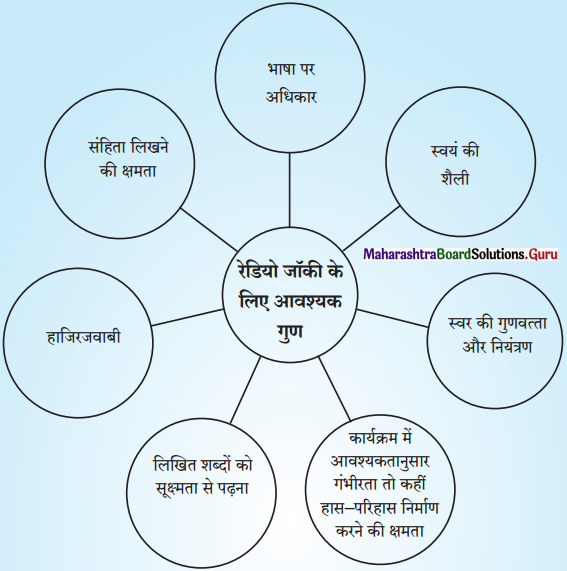Balbharti Maharashtra State Board Hindi Yuvakbharati 11th Digest परिशिष भावार्थ : भक्ति महिमा और बाल लीला Notes, Questions and Answers.
Maharashtra State Board 11th Hindi परिशिष भावार्थ : भक्ति महिमा और बाल लीला
भावार्थ : पाठ्यपुस्तक पृष्ठ क्रमांक २० : पाठ – भक्ति महिमा – संत दादू दयाल
जो माया–मोह का रस पीते रहे, उनका मक्खन–सा हृदय सूखकर पत्थर हो गया किंतु जिन्होंने भक्ति रस का पान किया, उनका पत्थर हृदय गलकर मक्खन हो गया। उनका हृदय प्रेम से भर गया।

अहंकारी व्यक्ति से प्रभु दूर रहता है। जो व्यक्ति प्रभुमय हो जाता है, फिर उसमें अहंकार नहीं होता। मनुष्य का हृदय एक ऐसा सँकरा महल है, जिसमें प्रभु और अहंकार दोनों साथ–साथ नहीं रह सकते। अहंकार का त्याग करना अनिवार्य है।
दादू मगन होकर प्रभु का कीर्तन कर रहे हैं। उनकी वाणी ऐसे मुखरित हो रही है जैसे ताल बज रहा हो। यह मन प्रेमोन्माद में नाच रहा है। दादू के सम्मुख दीन–दुखियों पर विशेष कृपा करने वाला प्रभु खड़ा है।
जिन लोगों ने भक्ति के सहारे भवसागर पार कर लिया, उन सभी की एक ही बात है कि भक्ति का संबल लेकर ही सागर को पार किया जा सकता है। सभी संतजन भी यही बात कहते हैं। अन्य मार्गदर्शक, जीवन के उद्धार के लिए जो दूसरे अनेक मार्ग बताते हैं, वे भ्रम में डालने वाले हैं। प्रभु स्मरण के सिवा अन्य सभी मार्ग दुर्गम हैं।
प्रेम की पाती (पत्री) कोई विरला ही पढ़ पाता है। वही पढ़ पाता है, जिसका हृदय प्रेम से भरा हुआ है। यदि हृदय में जीवन और जगत के लिए प्रेम भाव नहीं है तो वेद–पुराण की पुस्तकें पढ़ने से क्या लाभ ?
कितने ही लोगों ने वेद–पुराणों का गहन अध्ययन किया और उसकी व्याख्या करने में लिख–लिखकर कागज काले कर दिए लेकिन उन्हें जीवन का सच्चा मार्ग नहीं मिला। वे भटकते ही रहे, जिसने प्रिय प्रभु का एक अक्षर पढ़ लिया, वह सुजान–पंडित हो गया।

मेरा अहंकार – “मैं’ ही मेरा शत्रु निकला, जिसने मुझे मार डाला, जिसने मुझे पराजित कर दिया। मेरा अहंकार ही मुझे मारने वाला निकला, दूसरा कोई और नहीं।
अब मैं स्वयं इस ‘मैं’ (अहंकार) को मारने जा रहा हूँ। इसके मरते ही मैं मरजीवा हो जाऊँगा। मरा हुआ था फिर से जी उठूगा। एक विजेता बन जाऊँगा।
हे सृष्टिकर्ता ! जिनकी रक्षा तू करता है, वे संसार सागर से पार हो जाते हैं।
और जिनका तू हाथ छोड़ देता है, वे भवसागर में डूब जाते हैं। तेरी कृपा सज्जनों पर ही होती है।
रे नासमझ ! तू क्यों किसी को दुख देता है। प्रभु तो सभी के भीतर हैं। क्यों तू अपने स्वामी का अपमान करता है? सब की आत्मा एक है। आत्मा ही परमात्मा है। परमात्मा के अलावा वहाँ दूसरा कोई नहीं।
इस संसार में केवल ऐसे दो रत्न हैं, जो अनमोल हैं। एक है सबका स्वामी–प्रभु। दूसरा स्वामी का संकीर्तन करने वाला संतजन, जो जीवन और जगत को सुंदर बनाता है।
इन दो रत्नों का न कोई मोल है, न कोई तोल ! न इनका मूल्यांकन हो सकता है, न इन्हें खरीदा जा सकता है, न तौला जा सकता है।
भावार्थ : पाठ्यपुस्तक पृष्ठ क्रमांक २४ : पाठ – बाल लीला – संत सूरदास
1. यशोदा अपने पुत्र को चुप करने के लिए बार–बार समझाती है। वह कहती है – “चंदा आओ ! तुम्हें मेरा लाल बुला रहा है। यह मधु मेवा, पकवान, मिठाई स्वयं खाएगा और तुम्हें भी खिलाएगा। (मेरा लाल) तुम्हें हाथ में रखकर खेलेगा; तुम्हें जरा भी भूमि पर नहीं बिठाएगा।”

यशोदा हाथ में पानी का बर्तन उठाकर कहती है – “चंद्रमा ! तुम शरीर धारण कर आ जाओ।’ फिर उन्होंने जल का पात्र भूमि पर रख दिया और उसे दिखाने लगी – ‘बेटा देखो ! मैं वह चंद्रमा पकड़ लाई हूँ।’ अब सूरदास के प्रभु श्रीकृष्ण हँस पड़े और मुस्कुराते हुए उस पात्र में बार–बार दोनों हाथ डालने लगे।
2. हे श्याम ! उठो, कलेवा (नाश्ता) कर लो। मैं मनमोहन के मुख को देख–देखकर जीती हूँ। हे लाल ! मैं तुम्हारे लिए छुहारा, दाख, खोपरा, खीरा, केला, आम, ईख का रस, शीरा, मधुर श्रीफल और चिरौंजी लाई हूँ। अमरूद, चिउरा, लाल खुबानी, घेवर–फेनी और सादी पूड़ी खोवा के साथ खाओ।
मैं बलिहारी जाऊँ। गुझिया, लड्डू बनाकर और दही लाई हूँ। तुम्हें पूड़ी और अचार बहुत प्रिय हैं। इसके बाद पान बनाकर खिलाऊँगी। सूरदास कहते हैं कि मुझे पानखिलाई मिले।
